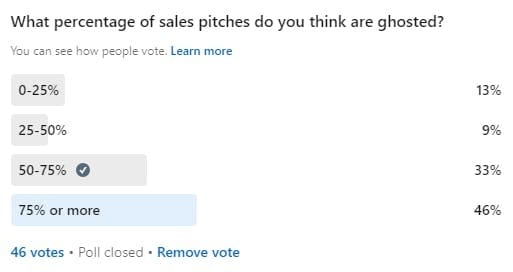- B2Breakout
- Posts
- Giving up the Ghost: Smart Ways You Can Avoid Being Sales Ghosted 👻
Giving up the Ghost: Smart Ways You Can Avoid Being Sales Ghosted 👻
Picture the scene.
You’re in the middle of a great sales call. You’re hitting all your points, the conversation is flowing, the customer seems genuinely interested.
So the logical next step: you offer to send a proposal over.
That sounds great,” they say, immediately. Result.
You finish the call. This is you:

Then you beaver away at designing a proposal perfectly suited to the conversation you just had - all the pain points they have and all the ways you can solve them.
You send it over.
Then… silence.
That’s not immediately concerning. But then there’s more silence.
So you follow up in maybe a week.
Silence, again.
You follow up, one more time.
Now, you’re feeling more like this:

You follow up a few more times. But eventually, you give up and move the lead to ‘lost’ in your CRM.
Congratulations: you’ve officially just been ghosted. 👻
It’s incredibly frustrating. All that work, for nothing.
It’s also not unique. It actually happens to everyone.

In fact, we recently found that 80% of businesses expect their sales efforts to get ghosted more than half the time.
That's a huge amount of wasted man hours.
In other words, it isn’t just your house that's haunted. It’s the whole neighbourhood.
And you know the worst part?
You’re part of the problem.
(Stay with me, here)
Let me ask you: When did you last ghost someone?
(Let’s be honest - you have)
Now: think about why you did it.
I think there are a couple of likely reasons:
You were kind of interested, but not ready to go ahead.
You changed your mind between the call and receiving the proposal.
You figured that saying ‘Yes’ to a proposal is the easiest way to end the call - you had no intention of signing up.
You were irritated by being ghosted and wanted to burn someone else as revenge.
There’s no judgement on this (except for the last one - that is just mean). All of these are valid reasons.
Why? Because the onus is on the proposer to make their proposal amazing.
If you’re not blown away by it - then you have every right to ghost.

So From The Other Side Of The Coin… How Do You Give Up The Ghost?
When you get ghosted after sending a proposal, it’s difficult not to take it personally.
The key is to change your process, so you always end up being less likely to be ghosted.
For example, pitching directly through DMs and content will get you conversations.
But they are just that - conversations.
It’s essentially a high-volume, low success strategy - like door to door sales.
It does work. That’s why people do it. But it’s hard.
And if your conversation is focused on building a rapport, talking about their needs and next steps, pitching, etc. - you either need to be incredibly good at selling, or your offer needs to be incredible.
And I mean far more incredible than it’s ever going to be.
Like free ice cream, forever. (Gluten-free and with no weight gain)
Remember: the moment you’ve sent over your proposal, you’ve played all your cards.
They can ignore you. And they will.
The answer: do more stuff up front, so your cards are worth more.

The Secrets to Ghostbusting
Switch To A Nurture Mindset (While Doing As Little As Possible)
The conversation and proposal shouldn’t be the first step in your relationship with your customer. If they are, you will probably fail. Especially if your efforts are all online.
In the comments, David drew on his own experiences of online selling to give us some great insight on this point.
It feels like this has become more frequent since I shifted to online only. Partly that could be a question of volume but also it’s much easier to ghost someone who you know you’re never going to see in person.
Instead of sending out a proposal straight away, that step should be the culmination of a long process of nurturing and relationship-building.
This means email chains, LinkedIn DMing, commenting, content, and lead magnets.
This is more work up-front - and it's harder online - but pays dividends after.
But don’t waste any more time and effort on your lead process than you have to.
This means - automate, automate, automate.
Connect your CRM to your email system. Make your lead magnets that trigger those email chains. Keep your proposal light-touch so you can alter it easily for each client.
When you finally have your conversation, it will be the final rung on the ladder.
Don’t Play Your Hand Too Soon
If you fire off your proposal after a conversation, you’ve played all your cards - the customer is now entirely in control.
Building in extra touch points avoids this trap. Smaller steps, including follow-up meetings, helps to keep you in constant contact and keeps the customer saying ‘yes’.
One option is booking in a ‘numbers call’ where you look at some projections based on your client’s successes to date.
Whatever you do - take it nice and slow. You’d rather have a sale in six months than not at all.
Never Fire Over A Proposal Without Being 90% Sure You’ll Succeed
A lot of B2B sales processes are designed like B2C processes.
Traffic → Landing Page → Pitch → Proposal → Conversion
But B2B sales don’t fall into this easy pattern. And sending over a proposal shouldn’t be something you do just to tick it off.
The most common approach to this kind of 'fire and forget' sales effort was summed up perfectly in the comments by Giancarlo:
I never, ever, reply to any cold email/call/etc. unless I see it's coming from someone who took the time to really check out me and what I do, and they think I could be interested.
It's clear that the potential reward is there - for a carefully considered proposal aimed at the right person.
This step should be the culmination of a long process of getting to know each other.
And if you know each other well, you’ll know beforehand whether they’re going to sign.
Sending your proposal shouldn’t be the last roll of the dice.
It should be a foregone conclusion instead.
Focus on solution-based relationships rather than a hit-and-run approach.
Who Ya Gonna Call?
Ghostbusting is never an exact science, but the above steps will help make sure that your proposal is designed to seal the deal, rather than something to be fired out with little hope of success.
Get it right, and you’ll be feeling more like this:

That's all from me for now. Till next week.
Murray

It can be a long process to get this all in place, but I’d love to hear if these insights work for you. You can DM me via LinkedIn or reply to this email with your thoughts or any questions you might have.
And if you’d prefer some direct feedback on your LinkedIn marketing efforts, I’d be happy to help. You can take our LinkedIn assessment and I’ll follow up with some free analysis a few days later.